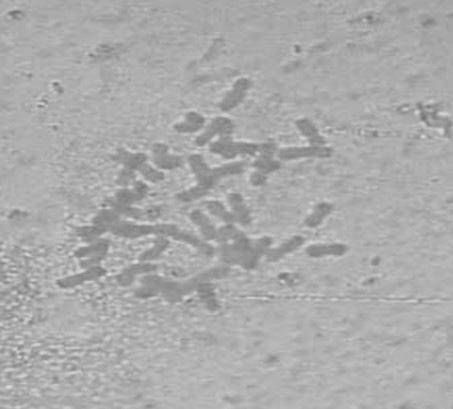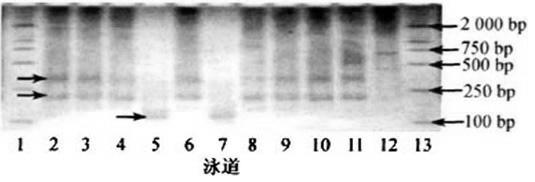Micro-dissection method for exogenous chromosomes in trititrigia alien substitution line
A technique for isomorphism and chromosome of echinopsis, which is applied in the field of molecular cytogenetics, can solve problems such as hindering the preparation of well-distributed chromosome specimens, affecting DNA sequences, and high DNA content, and achieves the advantages of easy screening and identification research, simple methods, and simple production Effect
- Summary
- Abstract
- Description
- Claims
- Application Information
AI Technical Summary
Problems solved by technology
Method used
Image
Examples
preparation example Construction
[0058] Step 1. Preparation of Wheat Root Tip Cell Chromosome Specimen
[0059] 1) Take 0.5 parts of Chinese spring wheat seeds and 0.5 parts of Shannong wheat seeds according to the ratio of parts by weight, mix them evenly, and then put the mixed wheat seeds in 2 parts of water, soak until they are white, take out the wheat seeds, and put them under temperature Place it at 1-4°C for 24 hours, then cultivate it at 25°C to germinate the wheat seeds, continue to cultivate until the root length of the new wheat is 1.5-2.0cm, take the root tip of 0.5-0.8cm, spare;
[0060] 2) Take the wheat root tips in step 1) and place them in the ice-water mixture at 0°C, and after standing for 24 hours, take out the wheat root tips and put them in 2-3 portions of Carnot’s solution at a temperature of 1-4°C, and place them After 24 hours, take it out, put the wheat root tip in 70% alcohol for later use;
[0061] 3) Preparation of reagents:
[0062] ① Mixed enzyme liquid: take 1 part of cellu...
Embodiment 1
[0098] The micro-segregation technique of exogenous chromosomes in trititie heterosubstitution lines comprises the following steps:
[0099] Step 1. Setting of SLμCELLCUT system parameters
[0100] 1) Illumination intensity of common light source
[0101] Set the illumination intensity of the common light source to 120V / 100W.
[0102] 2) Ultraviolet laser parameter setting
[0103] Under the illumination intensity of the ordinary light source of 120V / 100W, the parameters of the ultraviolet laser were set as follows: 100×objective lens, laser speed of 10, focus of 49, laser energy of 60, 40×objective lens, laser speed of 51, focus of 50. Laser energy is 75, 20×objective lens, laser speed is 59, focus is 74, laser energy is 66, 10×objective lens, laser speed is 49, focus is 72, laser energy is 79, 4×objective lens, laser speed is 82, focus is 79, laser energy is 70;
[0104] 3) Selection of cutting samples
[0105] Use the circular tools listed in the software to draw, comp...
Embodiment 2
[0166] The micro-segregation technique of exogenous chromosomes in trititie heterosubstitution lines comprises the following steps:
[0167] Step 1. Setting of SLμCELLCUT system parameters
[0168] 1) Illumination intensity of common light source
[0169] Set the illumination intensity of the common light source to 120V / 100W.
[0170] 2) Ultraviolet laser parameter setting
[0171] Under the illumination intensity of the ordinary light source of 120V / 100W, the parameters of the ultraviolet laser were set as follows: 100×objective lens, laser speed of 10, focus of 49, laser energy of 60, 40×objective lens, laser speed of 51, focus of 50. Laser energy is 75, 20×objective lens, laser speed is 59, focus is 74, laser energy is 66, 10×objective lens, laser speed is 49, focus is 72, laser energy is 79, 4×objective lens, laser speed is 82, focus is 79, laser energy is 70;
[0172] 3) Selection of cutting samples
[0173] Use the circular tools listed in the software to draw, comp...
PUM
 Login to View More
Login to View More Abstract
Description
Claims
Application Information
 Login to View More
Login to View More - R&D
- Intellectual Property
- Life Sciences
- Materials
- Tech Scout
- Unparalleled Data Quality
- Higher Quality Content
- 60% Fewer Hallucinations
Browse by: Latest US Patents, China's latest patents, Technical Efficacy Thesaurus, Application Domain, Technology Topic, Popular Technical Reports.
© 2025 PatSnap. All rights reserved.Legal|Privacy policy|Modern Slavery Act Transparency Statement|Sitemap|About US| Contact US: help@patsnap.com



